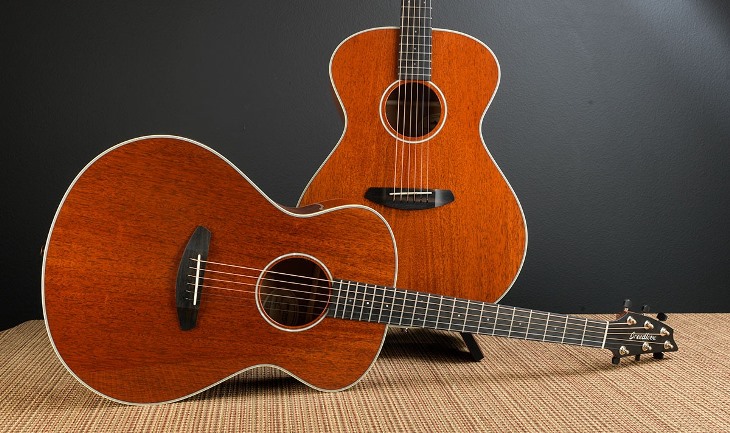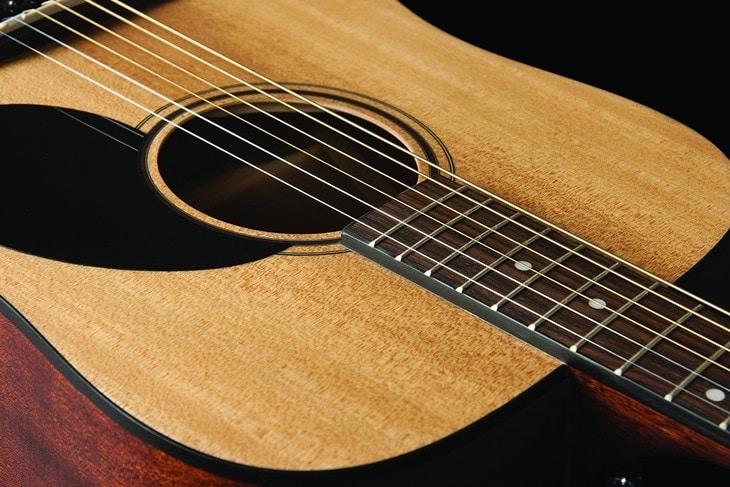I think we all share the same basic perceptions about what guitars are made of – higher quality and more expensive means better. Also, you can never go wrong with mahogany.
But is that necessarily true or could you get a comparable quality in tone with a cheaper material? Enter nato wood.
Nato wood is a cheaper alternative to mahogany and is used by many companies for their entry level ranges of instruments.
“But why would I buy an entry level guitar made from cheap wood?” I hear you ask. Well, let’s go over some of the benefits and I think you’ll quickly see what I mean.
Table of Contents
What is Nato Wood?
Nato wood, or ‘eastern mahogany’ as it is also sometimes referred to, is a collective term for the wood of Mora trees. Mora trees are native to the rainforests of South and Central America, and the Caribbean Islands.
It is called ‘eastern mahogany’ because of its similar appearance to mahogany, with its light to medium reddish-brown heartwood, but the two are from different species of trees.
Mahogany

A tried and true staple of the guitar world, mahogany is the most widely used wood in the making of guitars.
Genuine mahogany is sourced from places such as Mexico, Southern Amazonia, Florida and the Caribbean, and its cheaper cousin, African mahogany, from the Congo and West Africa.
Reasonably priced, easy to work with and pleasant looking and sounding, no wonder mahogany is so common. Although not as distinct sounding as something like maple, swamp ash, or basswood, mahogany’s warm tone is still recognizable.
Tone and Feel
Because nato and mahogany are so similar, both in texture and the way they look, you can expect them both to sound and play fairly similarly.
Both have quite warm tones, having almost the warmest tones of all the woods, with only really rosewood being warmer.
The only real difference, and it is quite a subtle one, is that nato wood guitars tend to have a slightly ‘crisper’ sound than mahogany.
So, Why Go Nato?

What are you gaining from going with a guitar made from a cheaper wood? Well, the obvious answer: price.
Going with a cheaper guitar made from nato wood could just be as simple as that when you’re working on a budget and can’t afford a more expensive guitar made from traditional mahogany.
While Buying Someone’s First Guitar
Perhaps you’re buying your first guitar or your son or daughter’s first guitar, and spending a lot of money just doesn’t make sense.
To Practice or Travel With
Another possible reason could be that you want a cheaper guitar because you might not want to carry around that expensive Ibanez Jem of yours when going to your band’s practice sessions. Or perhaps you’re just recording demos for your next album, and tone isn’t a major concern.
Well, a guitar made with nato wood is a good cheap alternative that still gives a tone that is comparable to one made from mahogany. So, you’re spending less without any significant compromise.
As a Second Guitar
Because of nato wood’s ‘crisper’ sound, especially if you plan on using high-output pickups, could make it a good choice as a second guitar for tracking purposes. So, you use a guitar made with traditional mahogany to get a nice warm, ‘muddier’ tone, and then use a nato guitar for the doubling track to get that ‘crisper’, but still warm tone.
Sustainability
Another very good reason to go with a nato wood guitar is for its sustainability. Due to the ever-growing deforestation, and 70% of mahogany trees being cut down between 1950 and 2003, CITES – the Convention on International Trade on Endangered Species, has limited the trade of mahogany and many other kinds of wood.
This has made more abundant and inexpensive woods like nato much more appealing to manufacturers such as Fender and Gibson, reserving woods like rosewood, alder, mahogany, etc. for their more high-end and niche range of instruments.
Conclusion
If you’re working on a tight budget, buying a first guitar, or simply looking for a no-compromise alternative to mahogany, then you’re not going to go wrong with a guitar made from nato wood. It’s cheap, sustainable, and nearly identical to mahogany with a slightly ‘crisper’ tone.


I just purchased a “Jasmine” guitar and I love the sound, didn’t expect this round crisp sound coming from this “cheap” guitar.
Oh yeah, the neck is “NATO wood”.
I very much appreciate the “education” you just gave me on Nato wood. I especially like the fact that it is currently a less expensive, more sustainable pure Mahogany substitute. And if it gives you the sound and warmth of Mahogany, so much the better.